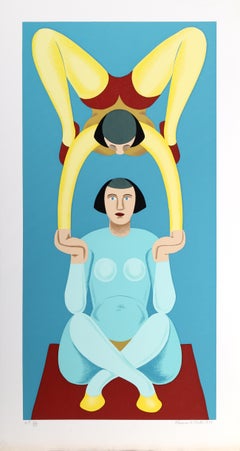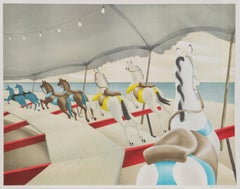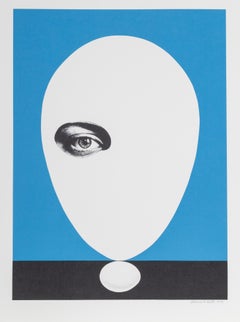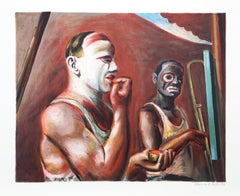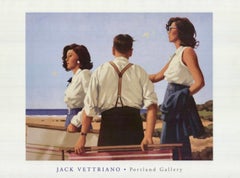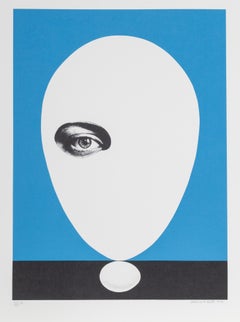Clarence Holbrook Carter Figurative Prints
American, 1904-2000
Clarence Holbrook Carter achieved a level of national artistic success that was nearly unprecedented among Cleveland School artists of his day, with representation by major New York dealers, scores of awards and solo exhibits, and streams of praise flowing from pens of the top art critics. Over the course of his 60+ year career Carter evolved from an exceptionally fine American Scene painter capable of evoking deep reservoirs of mood, into an abstractionist with a strongly surrealist bent.
While his two bodies of work seem at first to be worlds apart, owing to their different formal vocabularies, they, in fact, explore virtually the same subject: the nexus between life and death and the transition from earth to spirit. The early work finds its expressive power through specific people, events, and landscapes—most of which are drawn from his experiences growing up in the river town of Portsmouth, Ohio—while the later work from the 1960s on evokes potent states of being through pure flat shape, color and form that read as universals. As his primary form he adopted the ovoid or egg shape, endowing it with varying degrees of transparency. Alone or in multiples, the egg moves through Carter’s landscapes and architectural settings like a sentient spirit on a restless quest.
Born and raised in southern Ohio along the banks of the mercurial Ohio River and its treacherous floods, Carter developed a love of drawing as a child, and was encouraged by both his parents. He was self-directed, found inspiration all around him, and was strongly encouraged by the fact that his teenage work consistently captured art prizes in county and state fairs. Carter studied at the Cleveland School of Art from 1923-27, where he trained under painters Henry Keller, Frank Wilcox and Paul Travis.
Returning to Cleveland in 1929, Carter had his first solo show, and through Milliken taught studio classes at the Cleveland Museum of Art from 1930-37. In 1938, he moved to Pittsburgh to teach at the Carnegie Institute of Technology until 1944. Carter’s American Scene paintings of the ’30s and ’40s, which launched his artistic star, are the works for which the artist remains best known.
During and immediately after World War II, Clarence Carter realized his attraction to bold pattern, dramatic perspective and eye-catching hard-edged design was a poor fit with the prevailing style of Abstract Expressionism. Fortunately, these same hallmarks of his style were prized within the realm of commercial art.
Around 1964 Carter acknowledged a need to break from the confines of representational painting. Once Carter had found a potent symbol in the egg, he used it to create an astounding body of imagery for the rest of his life. Among the most ambitious of all his later paintings were his Transections, a theological term meaning to cross, specifically between life and death.to
2
2
Overall Width
to
Overall Height
to
2
1
1
109
859
382
377
308
4
4
2
2
2
1
1
1
1
1
2
2
4
Artist: Clarence Holbrook Carter
Acrobats, Signed Modern Screenprint by Clarence Carter
By Clarence Holbrook Carter
Located in Long Island City, NY
Acrobats
Clarence Holbrook Carter
American (1904–2000)
Date: 1979
Screenprint, signed and numbered in pencil
Edition: AP 30
Size: 40 x 22 in. (101.6 x 55.88 cm)
Category
1970s American Modern Clarence Holbrook Carter Figurative Prints
Materials
Screen
Carousel by the Sea, Signed Lithograph by Clarence Carter
By Clarence Holbrook Carter
Located in Long Island City, NY
Artist: Clarence Holbrook Carter, American (1904 - 2000)
Title: Carousel
Year: 1979
Medium: Lithograph, signed and numbered in pencil
Edition: 200, 30 AP
Size: 26 in. x 31.5 in. (66....
Category
1970s American Modern Clarence Holbrook Carter Figurative Prints
Materials
Lithograph
Balancing Act, Surrealist Screenprint by Clarence Holbrook Carter
By Clarence Holbrook Carter
Located in Long Island City, NY
Artist: Clarence Holbrook Carter, American (1904 - 2000)
Title: Balancing Act
Year: 1976
Medium: Serigraph, signed and numbered in pencil
Edition: 200, A...
Category
1970s Surrealist Clarence Holbrook Carter Figurative Prints
Materials
Screen
Clowns Making Up, Modern Lithograph by Clarence Holbrook Carter
By Clarence Holbrook Carter
Located in Long Island City, NY
Artist: Clarence Holbrook Carter, American (1904 - 2000)
Title: Clowns Making Up
Year: 1979
Medium: Lithograph, signed and numbered in pencil
Edition: 200, AP 30
Image Size: 19 x 23....
Category
1970s Contemporary Clarence Holbrook Carter Figurative Prints
Materials
Lithograph
Related Items
Swimmer - Screenprint (Olympic Games Munich 1972)
By Ronald Brooks Kitaj
Located in Paris, IDF
Ronard Brooks KITAJ
Swimmer
Screen print
Signature printed in the plate
On heavy paper 101 x 64 cm (c. 40 x 26 inch)
Made for the Olympic Games in Munich, 1972
Excellent condition
Category
1970s American Modern Clarence Holbrook Carter Figurative Prints
Materials
Screen
Young Hearts, Portland Gallery London offset lithograph
By Jack Vettriano
Located in Hillsborough, NC
Jack Vettriano (1951-) is renowned for his film noir oil paintings and 1930s glam style. Uniquely Vettriano, ‘Young Hearts’ is set by the seaside inviting narratives about the figures in his work: relationships, anticipation, power and suggestion.
Vettriano grew up by the Fife Scottish coast. He began painting beach scenes as a young adult, later developing his particular recognizable style and thematic imagery. His work was embraced by celebrities such as Madonna and Jack Nicholson and he has become hugely successful. His most famous painting, ‘The Singing Butler...
Category
Early 2000s Contemporary Clarence Holbrook Carter Figurative Prints
Materials
Lithograph, Offset
Headstand (San Francisco Museum of Modern Art) - Exhibition Poster
By Keith Haring
Located in Paris, IDF
Keith Haring
Headstand
Original vintage exhibition Poster printed in Screenprint
On thick paper
90 x 60 cm (c. 36 x 24 in)
INFORMATION: Official screenprint poster for the Haring e...
Category
1980s American Modern Clarence Holbrook Carter Figurative Prints
Materials
Screen
Original Pan American World Airways by Clipper to Portugal and Spain poster
By Jean Carlu
Located in Spokane, WA
Original vintage poster: Portugal and Spain by Pan American World Airways Clipper, Artist: Jean Carlu. Pan American original vintage poster large travel size format 27.5" x 41.1" Earliest version (the 1950s) of the poster for travel by Constellation aircraft.
Original linen-backed, Pan American World Airways by Clipper vintage poster for travel to Portugal and Spain. Wear and stress marks in the top and bottom dark area but are not tears.. Small touch-up on the left white border.
In the middle of this image, it features a matador with a cape hanging off his shoulder. Surrounding the image in vignettes of cut-out windows showing typical landscape scenes and castles. A great smaller format original for "The World's Most Experienced Airline". One of the windmills shown in this image has cloth sails. Trimming the sails allowed the windmill to turn at near the optimal speed in a large range of wind velocities. Pan American World Airways by Clipper.
Pan American a.k.a. Pan Am Airlines posters are very collectible and rare year to year. This a great design opportunity for a home with a European flair. The Pan Am Clipper...
Category
1950s American Modern Clarence Holbrook Carter Figurative Prints
Materials
Lithograph
$1,598
H 42 in W 27.5 in D 0.05 in
Cathedral of Christ the Savior. 1989., paper, screen print, 60x32.5 cm
Located in Riga, LV
Cathedral of Christ the Savior. 1989, paper, screen print, 60x32.5 cm
Category
1980s Surrealist Clarence Holbrook Carter Figurative Prints
Materials
Paper, Screen
$853 Sale Price
20% Off
H 23.63 in W 12.6 in D 0.04 in
Ratfinkbonerthunk : Surrealist Rat - Original Giclee Print, Handsigned
By Kenny Scharf
Located in Paris, IDF
Kenny Scharf
Ratfinkbonerthunk : Surrealist Rat, 1990
Original Giclee Print
Handsigned in pencil
On Arches vellum 56 x 76 cm (c. 22 x 30 in)
Published by Editions Vermorel in 1990
...
Category
1990s American Modern Clarence Holbrook Carter Figurative Prints
Materials
Giclée, Screen
$1,778
H 22.05 in W 29.93 in
Untitled (Smile-ism No. 20)
By Yue Minjun
Located in Calabasas, CA
Artist: Yue Minjun
Title: Untitled (Smile-ism No. 20)
Year: 2006
Medium: Lithograph on Rives BFK paper
Edition: 45; signed and numbered in pencil
Sheet: 43.50 x 35.25 in. (110.5 x 8...
Category
Early 2000s Contemporary Clarence Holbrook Carter Figurative Prints
Materials
Lithograph
Rodeo Queen by Luis Jimenez
Located in Phoenix, AZ
Rodeo Queen, 1981
Edition 36/50
Signed lower left, Inscribed: for the "Rose" 82.
Provenance: Print was a gift to Rozanne Charington, companion and model for "Rodeo Queen", "Rose Tattoo" and "Jimenez at Adeliza's Candy Store".
Lithograph on paper
42 ½ × 29 in. (107.3 × 73.7 cm)
Luis Alfonso Jimenez
Born, 1940, El Paso, Texas, died 2006, Hondo, New Mexico.
Statement: Luis Jimenez, in his work, celebrates the vitality of life. . . . Jimenez es un hijo de la frontera; he knows its people and the landscape. It is the transformation of these people into art that is his most important contribution to the art of this vast region which stretches between Mexico and the United States.
His subject matter utilizes the popular images of the cultura del norte, and a large part of it is depicted and transformed in the rough and tumble world of la frontera. He is also a son of el norte, and so he uses its materials and explores its emerging, popular myths. The tension and attraction of Jimnez’s work is that he always creates within the space of his two worlds, the Mexicano and the Americano. He constantly shows us the irony of the two forces which repel, while showing us glimpses of the synthesis he seeks. What a gift it has been to us for this talented artist to reflect on the soul of our region. He gives meaning to our existence and history.
Rudolfo Anaya (passage chosen by the artist), A View from La Frontera, Man on Fire: Luis Jimenez, pp. 1, 3, 6Biography: Luis Jimenez was born in Texas to parents who had emigrated from Mexico to the United States; he would later dedicate his 1989 sculpture Border Crossing to his father, who had entered the country illegally. The elder Jimenez was a neon sign designer in El Paso, and Luis worked with him as a youth. His experience working in the neon shop and his fascination with U.S. car culture would both become major influences on his art career.
Jimenez studied architecture at the University of Texas, Austin (UTA), and also took art courses in which he first created sculptures with wood, steel, and fiberglass, choosing the latter because of its association with U.S. popular culture. He subsequently became one of the artists who made fiberglass an acceptable medium in the 1960s. In 1964 Jimenez received his B.S. in art from UTA, and he continued his studies at the Universidad Nacional Autonoma de Mexico in Mexico City.
In 1966 he moved to New York City and worked as an assistant to sculptor Seymour Lipton. Jimenez began to exhibit his art while in New York and in 1972 moved to New Mexico to focus on creating public sculptures, even as he maintained his diverse output of drawings, prints, and lithographs.
Drawing on his early experiences, Jimenez creates works that come from a border perspective, one that draws upon the hybridity bred by culture clashes. Often socially and politically informed, his works speak not only in regional terms, those germane to the southwestern United States, but to broader, more global issues as well. They exhibit a profoundly Chicano aesthetic and sensibility, one that is informed by Mexican and Mexican American traditions, North American popular culture, Chicano cultural icons, and images and themes unique to the Southwest. Death, sexuality, and the struggle of the common people are frequent themes.
Inspired by authors who write in an autobiographical style, Jimenez creates works that function as personal narrative yet are also able to make statements about culture in more global terms. His use of bold colors and lines, a legacy from his fathers work as a neon sign maker, lends a dynamic sensuality to his work, one that is particularly evident in his monumental fiberglass and acrylic urethane sculptural works
Many of Jimenez's works correspond to scholar Toms Ybarra-Fraustos definition of the Chicano aesthetic of rasquachismo, a lowbrow sensibility that appeals to the working class in that it applies to objects that subvert expressions of the mainstream or dominant culture. Creating art that speaks to the people, Jimenez is able to transform regional and culturally specific myths and symbols into globally recognized and relevant icons.
Exhibitions:
In addition to his personal work, Jimenez has been commissioned for numerous public art projects. In 1999 his sculpture Southwest Piet was designated a National Treasure by First Lady Hillary Clinton.
The many exhibitions featuring his work have included Human Concern/Personal Torment (Whitney Museum of American Art, New York, 1969).
The First International Motorcycle Art Show (Phoenix Art Museum, Phoenix, AZ, 1973).
Three Texas Artists (Centre Cultural Americaine, USIS, Paris, 1977),
Recent Trends in Collecting (Smithsonian Institution, Washington, DC, 1982).
Committed to Print (Museum of Modern Art, New York, 1989)
Printmaking in Texas: The 1980s (Modern Art Museum, Fort Worth, TX.
Laguna Gloria Art Museum, Austin, 1990.
The Whitney Biennial (Whitney Museum of American Art, New York, 1991)
Man On Fire: Luis Jimnez (Albuquerque Museum of Art, NM, 1994-95).
47th Annual Purchase Exhibition (American Academy of Arts and Letters, New York, 1995).
Traveling solo exhibition, Working Class Heroes: Images from the Popular Culture (1997-2000).
Jiménez
Collier Gallery has been in continuous operation for over 40 years. Originally located just off Main Street in downtown Scottsdale, Arizona, we have moved to Phoenix to accommodate and showcase our large inventory including:
• Original works by Maynard Dixon, Lon Megargee, Ed Mell, Fritz Scholder, Bill Schenck, Bill Lesch, Luis Jimenez, Greg
Singley, Dan Budnik, and other 20th century Western, WPA and Contemporary Southwestern artists.
• The Fine Art Estate of Lon Megargee
• Vintage rodeo...
Category
1980s Contemporary Clarence Holbrook Carter Figurative Prints
Materials
Lithograph
Harry Shokler, Island Harbor
By Harry Shokler
Located in New York, NY
Harry Shokler used serigraphy to great advantage in this landscape. It's colorful and detailed.
It is signed in the image at the lower left. When printmakers began making serigraphs...
Category
1940s American Modern Clarence Holbrook Carter Figurative Prints
Materials
Screen
Hand of Africa - Mandela, Former South African President, Signed Artwork, Hand
By Nelson Mandela
Located in Knowle Lane, Cranleigh
Nelson Mandela, Hand of Africa, Signed Limited Edition Lithograph
Many people are unaware that Nelson Mandela turned his hand to art in his 80's as a way of leaving a legacy for his ...
Category
Early 2000s Contemporary Clarence Holbrook Carter Figurative Prints
Materials
Lithograph
$20,131
H 25.5 in W 20 in D 2 in
Original Mardi Gras New Orleans 1978 festival serigraph poster
Located in Spokane, WA
Original Mardi Gras, New Orleans, 1978 linen-backed poster. Dressed up in what would be an American Indian costume with full headgear, he is holding a shield with a horse on it. Indian decoration on the footwear. Signed and numbered.
I believe this has to deal with Big Chief leading his Congo Nation Mardi Gras Indian group. Zulu Parade. Many of the original Mardi Gras jazz posters...
Category
1970s American Modern Clarence Holbrook Carter Figurative Prints
Materials
Screen
$636 Sale Price
20% Off
H 32 in W 23 in D 0.05 in
"Labor in a Diesel Plant" Machine Age American Scene Industrial Mid 20th Century
By Letterio Calapai
Located in New York, NY
"Labor in a Diesel Plant" Machine Age American Scene Industrial Mid 20th Century
Letterio Calapai (American 1902-1993)
''Labor in A Diesel Plant''
Wood engraving, 1940
17 x 10 1/2...
Category
1940s American Modern Clarence Holbrook Carter Figurative Prints
Materials
Lithograph
$6,900
H 23 in W 16 in D 2 in
Previously Available Items
Balancing Act
By Clarence Holbrook Carter
Located in Long Island City, NY
Artist: Clarence Holbrook Carter, American (1904 - 2000)
Title: Balancing Act
Year: 1976
Medium: Serigraph, signed and numbered in pencil
Edition: 200, A...
Category
1970s Surrealist Clarence Holbrook Carter Figurative Prints
Materials
Screen
Carousel by the Sea
By Clarence Holbrook Carter
Located in Long Island City, NY
Artist: Clarence Holbrook Carter, American (1904 - 2000)
Title: Carousel
Year: 1979
Medium: Lithograph, signed and numbered in pencil
Edition: 200, 30 AP
Size: 26 in. x 31.5 in. (66....
Category
1970s American Modern Clarence Holbrook Carter Figurative Prints
Materials
Lithograph
"Outside the Limits (Fireworks Stand)" by Clarence Holbrook Carter
By Clarence Holbrook Carter
Located in Long Island City, NY
Artist: Clarence Carter Holbrook
Title: Outside the Limits (Fireworks Stand)
Year: 1979
Medium: Lithograph, signed and numbered in pencil
Edition: AP ...
Category
1970s American Realist Clarence Holbrook Carter Figurative Prints
Materials
Lithograph
Clarence Holbrook Carter figurative prints for sale on 1stDibs.
Find a wide variety of authentic Clarence Holbrook Carter figurative prints available for sale on 1stDibs. If you’re browsing the collection of figurative prints to introduce a pop of color in a neutral corner of your living room or bedroom, you can find work that includes elements of blue and other colors. You can also browse by medium to find art by Clarence Holbrook Carter in lithograph, screen print and more. Much of the original work by this artist or collective was created during the 1970s and is mostly associated with the Surrealist style. Not every interior allows for large Clarence Holbrook Carter figurative prints, so small editions measuring 26 inches across are available. Customers who are interested in this artist might also find the work of John Hultberg, André Thomkins, and Roger Chapelain Midy. Clarence Holbrook Carter figurative prints prices can differ depending upon medium, time period and other attributes. On 1stDibs, the price for these items starts at $520 and tops out at $900, while the average work can sell for $710.
